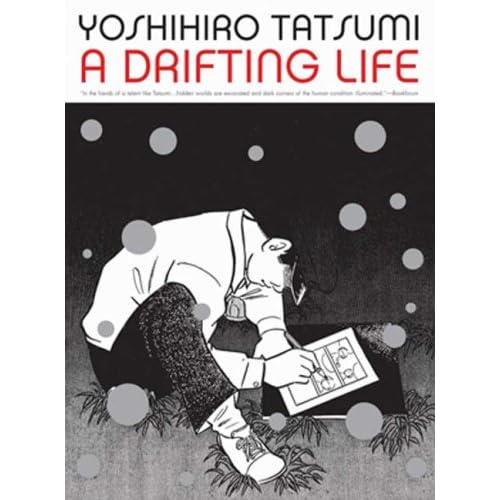
Honestly, I'm not completely certain that I was completely satisfied with this book. It's a memoir by Yoshihiro Tatsumi of his early days in Japan's fledgling comics industry in the 1950s, and it's a gargantuan read at 840 pages. If you're looking for anecdotes about life in postwar Japan, or how small publishers started finding new talent to get on board the emerging market for rental books full of short comics, then you will certainly find this a captivating read.
Personally, I found the book very frustrating for what it didn't tell. I take from clues issued by Drawn & Quarterly, and by the cartoonist Adrian Tomine, who has championed his work and acted as Tatsumi's English-language editor, that Tatsumi belongs to a school of alternative cartoonists in Japan, eschewing the fantastic series that result in worldwide fame and merchandising in favor of either crime dramas or slice-of-life stories, without continuing characters. Yet there is very little in A Drifting Life to explain Tatsumi's place in the industry, save some very nebulous attempts at explaining the differences between "manga," "gegika" and "komaga."
By the end of the narrative, we have learned of several stories that Tasumi has had published in a number of anthology books, but we never learn how these are received, whether they're considered important, or even whether they are available in English. My guess is that they aren't; Wikipedia suggests that only a few works, no earlier than 1969, are available here. (Somebody could really stand to update Tatsumi's Wikipedia page, frankly.) For that matter, I was also very curious what became of Tatsumi's fellow artists. Osamu Tezuka and Takao Saito both feature in his story, and I recognized about two other names, but who were these other creators whose work ran alongside Tatsumi's in the pages of Shadow and City and Skyscraper? What did audiences think of them at the time, and did they move on to greater celebrity in the 1960s and 1970s?
For all my frustrations and misgivings, and unhappiness with the way the book ends with many subplots unresolved, I do agree that there's much to love about A Drifting Life. The narrative at least starts out fascinating before it starts feeling obscure, and I do love Tatsumi's style, mating simplistic caricatures of his players with detailed backgrounds. I like the way he includes just enough artistic details to define a strong sense of place, but never too many for the panels to become busy and cramped. You can tell the book is a labor of love, and it is frequently quite charming, and it has certainly encouraged me to look out for D&Q's other Tatsumi releases, but I also think readers with more background in the history are going to take a little more away from it. So, recommended with reservations.
1 comment:
Nice review. I too had similar annoyances... Who are these other artists? Are they also pseudonyms?
The D&Q anthologies give a good survey of Tatsumi's work:
http://www.drawnandquarterly.com/artStudio.php?artist=a41e32e169aff2
I'm disillusioned with Wikipedia recently (angry nerds keep paring down my "not notable" articles) but here's a more relevant page:
http://en.wikipedia.org/wiki/Gekiga
Post a Comment